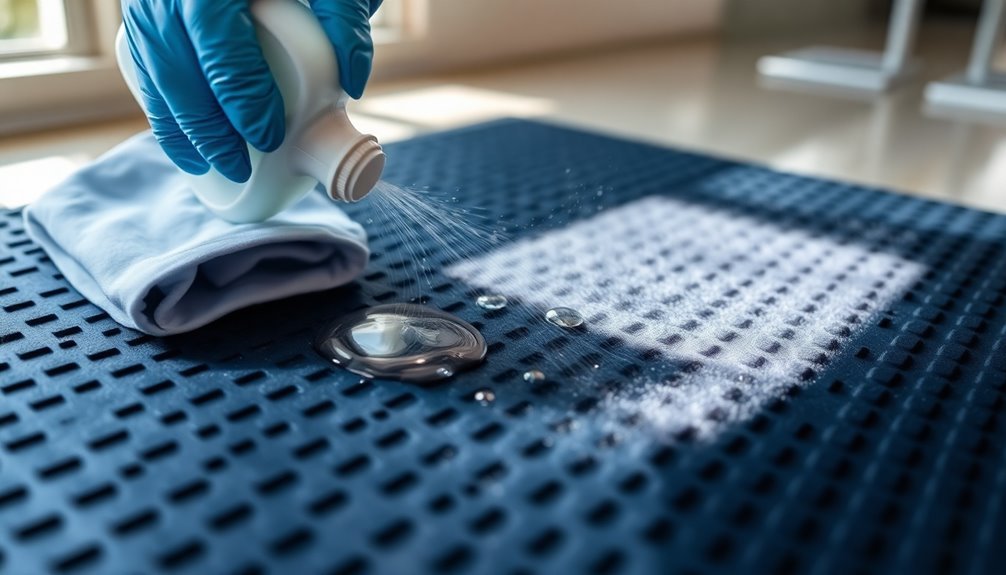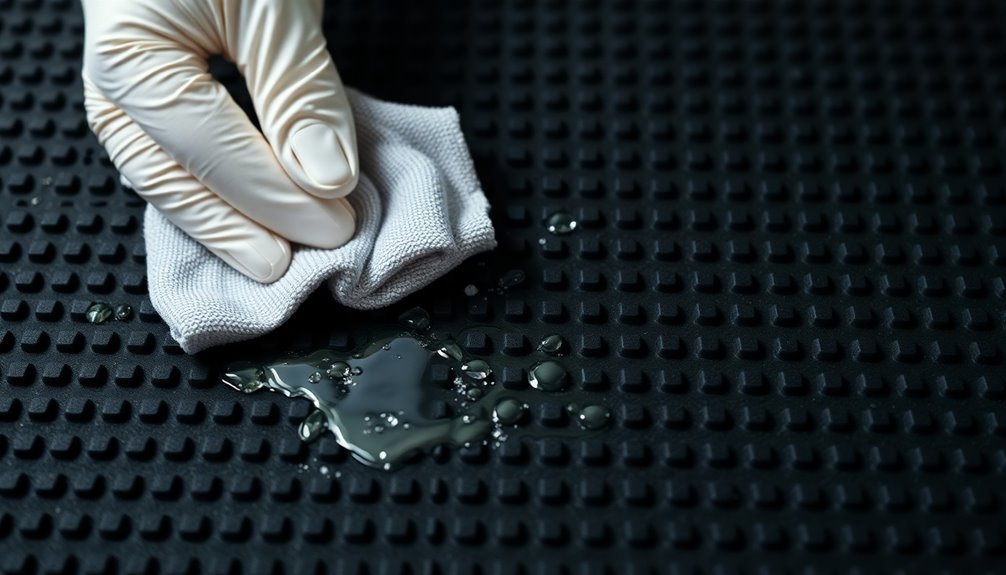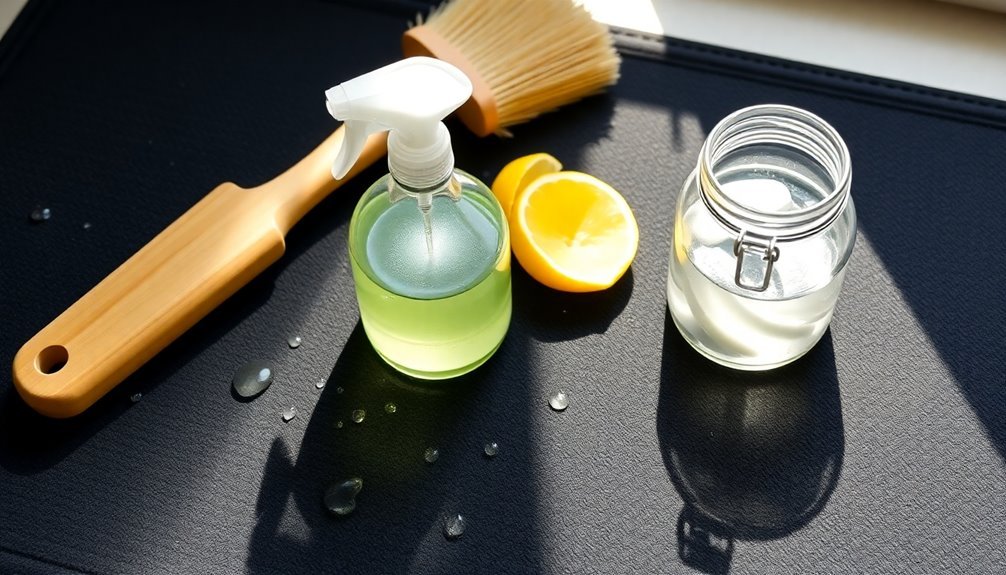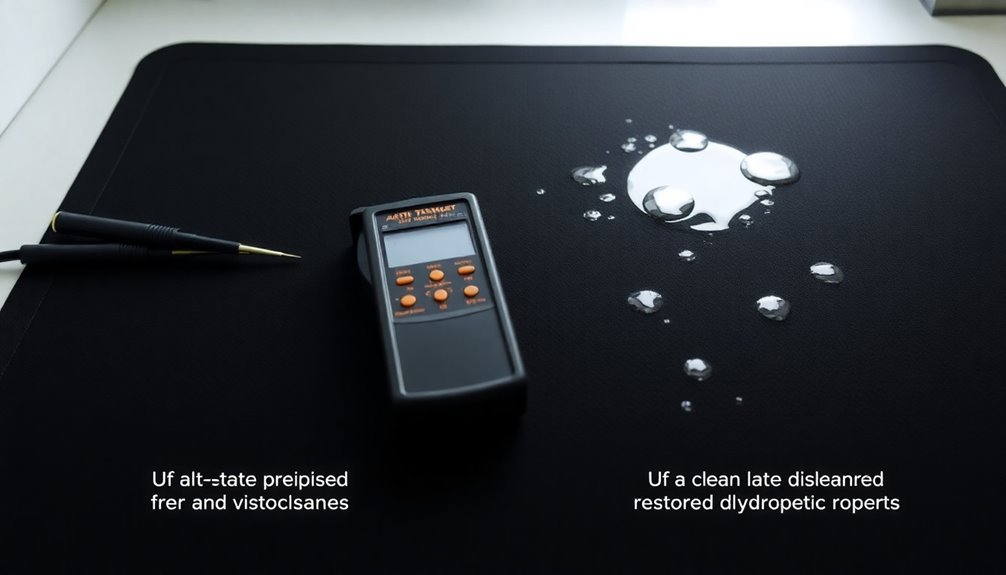To keep your ESD mat in top condition, you'll need seven proven cleaning solutions. Start with specialized ESD sprays like Reztore or Staticide for daily maintenance. Use a soft ESD-safe brush for dry cleaning to remove dust and debris. Professional mat cleaners maintain anti-static properties while eliminating tough stains. For light cleaning, try a damp lint-free cloth with distilled water. Choose eco-friendly biodegradable cleaners for sustainable maintenance. Deep clean stubborn spots by letting cleaners sit briefly before wiping. Always test your mat's resistance after cleaning. Discover how these methods can maximize your mat's lifespan and protection.
Daily Cleaning With ESD Sprays

Your ESD mat's daily cleaning routine requires specialized ESD sprays to maintain its anti-static properties effectively. You'll need to use specific cleaners like Reztore ESD Surface and Mat Cleaner or Staticide Mat and Table Cleaner, as household cleaners containing alcohol or silicone can damage your mat's protective qualities. Regular maintenance ensures optimal static elimination performance over time.
Don't forget to test your mat's anti-static performance after each cleaning session to verify it's maintaining its protective properties. If you're using your mat frequently, you'll want to clean it daily. However, if it sees less use, weekly cleaning might be adequate.
Remember to follow your cleaner's manufacturer instructions precisely, as different products may have specific application requirements. This consistent maintenance verifies your mat continues to protect your sensitive electronic components effectively.
Dry Brushing Maintenance Method
You'll need a soft ESD-safe brush or dry cloth as your primary tools for maintaining your ESD mat through dry brushing.
Start your daily cleaning routine by using gentle sweeping motions to remove dust and debris from the mat's surface. Surface dirt accumulation can significantly reduce the effectiveness of your ESD mat's static control properties.
Regular dry brushing not only keeps your mat clean but also helps maintain its anti-static properties when combined with proper ESD cleaning solutions. Regular sweeping is considered essential according to maintenance guidelines for ensuring optimal mat performance.
Basic Tools Needed
Maintaining an ESD mat requires just a few essential tools for effective dry brushing maintenance. You'll need a soft-bristled brush specifically designed for ESD mats to prevent static damage, along with a lint-free cloth to remove loose debris. It's vital to use tools that won't scratch or damage your mat's conductive layer while cleaning. Proper cleaning supplies enhance workplace safety by minimizing electrical hazards during maintenance. Compliance verification tests show that regular sanitizing helps maintain both ESD performance and workplace hygiene standards.
| Tool | Purpose |
|---|---|
| ESD Safe Brush | Removes particles without static generation |
| Lint-free Cloth | Wipes away loose debris safely |
| Soft-bristled Brush | Provides gentle surface cleaning |
| Cleaning Path Guide | Guarantees systematic coverage |
| Testing Equipment | Verifies mat functionality |
When selecting your tools, you'll want to make sure they're all ESD-safe to prevent static buildup during the cleaning process. Store your cleaning supplies in a clean, static-free environment to prevent contamination. You should apply gentle pressure while cleaning, as excessive force can damage the mat's conductive properties. Remember to follow your mat manufacturer's specific guidelines for cleaning tools and techniques. After cleaning, always test your mat to verify it maintains proper ESD protection. Regular inspection of your cleaning tools will help guarantee they're in good condition and won't damage your mat during maintenance.
Daily Brush Cleaning Steps
A proper dry brushing routine is essential for keeping ESD mats in ideal condition. Before you begin, verify you're using only ESD-safe tools and soft-bristled brushes to prevent damage to your mat's surface. Inspect your mat for signs of wear before starting the cleaning process.
Start by gently sweeping the mat from top to bottom using a soft-bristled brush to remove loose debris. Follow this with careful dry brushing motions to eliminate dust and dirt without scratching the surface. Use a lint-free cloth to wipe away any remaining particles. Accumulation of debris can create an insulating barrier between shoes and the mat surface.
Don't use strong solvents or abrasive materials, as these can compromise your mat's anti-static properties. Regular cleaning maintains optimal surface resistance values which is crucial for ESD protection.
You'll need to adjust your cleaning frequency based on usage. If you're using your ESD mat daily, clean it every day. For less frequent use, weekly cleaning might suffice. Always maintain a clean workspace around your mat to minimize dirt accumulation.
After cleaning, test your mat to confirm it retains its anti-static properties. Remember to follow your manufacturer's specific cleaning guidelines, and only use cleaners designed specifically for ESD mats when necessary.
Professional ESD Mat Cleaners

Professional cleaners like Static Care and Reztore offer superior protection for your ESD mat compared to generic cleaning solutions, as they're specifically engineered to maintain anti-static properties without leaving harmful residues.
You'll find these industry-standard products are worth the investment because they prevent the degradation that common household cleaners can cause to your mat's protective surface.
When applying these specialized cleaners, you should spray them directly onto your mat's surface and wipe in a circular motion with a lint-free cloth to guarantee ideal results.
Industry Standard Cleaning Solutions
Industry-standard cleaning solutions form the backbone of proper ESD mat maintenance. Products like ElectraMat and StaticCARE are specifically designed to clean and rejuvenate ESD surfaces without compromising their static control properties. You'll find these solutions available in various sizes, from 1-quart bottles to 5-gallon containers, complete with heavy-duty trigger sprayers.
When you're cleaning your ESD mat, you'll want to avoid harsh chemicals and generic cleaners that can damage the static dissipative properties. Instead, use these specialized solutions that are non-corrosive, non-flammable, and biodegradable. They're safe for both rubber and vinyl mats, as well as workbenches and tabletops.
To properly clean your mat, mist the solution and wipe with a lint-free cloth. For computer screens and acrylic surfaces, dilute the solution in a 1:4 ratio with water. You should always test the cleaner on an inconspicuous area first to verify compatibility.
Remember to check that all insulative contaminants have been removed after cleaning to maintain effective ESD protection. Regular cleaning is essential to prevent the buildup of substances that could compromise your mat's protective qualities.
Benefits Over Generic Cleaners
While generic cleaners might seem like a cost-effective option, specialized ESD mat cleaners offer distinct advantages that protect your investment and maintain ideal static control. These professional cleaners are specifically formulated to be non-corrosive and nonflammable, guaranteeing they won't damage your sensitive electronic components or leave harmful residues behind.
You'll find that professional ESD cleaners excel in versatility and compatibility. They're safe to use on various surfaces, including rubber and vinyl anti-static mats, workbenches, and even computer screens when properly diluted. Unlike generic alternatives, they're designed to preserve your mat's antistatic properties while effectively removing tough contaminants like grease and nicotine.
The environmental benefits shouldn't be overlooked. Most professional ESD cleaners are biodegradable and non-toxic, making them a sustainable choice for your workspace. They're also concentrated, so you'll use less product to achieve better results.
Regular use of these specialized cleaners will extend your mat's lifespan, maintain its electrical performance, and guarantee consistent ESD protection. By investing in professional ESD mat cleaners, you're not just cleaning your workspace – you're maintaining a critical safety component of your ESD-protected area.
Proper Application Techniques
Successful cleaning of your ESD mat starts with the right application technique. You'll need to choose between dry and wet cleaning methods, depending on the level of contamination. For basic maintenance, use a cleaning brush, broom, or dry cloth to remove surface debris.
When wet cleaning is necessary, apply an approved ESD mat cleaner using a spray bottle or damp mop. Don't flood the mat with solution – a light application is sufficient. Use a lint-free cloth or paper towel to wipe the cleaner, moving in vertical, horizontal, or circular motions for thorough coverage.
If you're cleaning floor mats, use a damp cotton mop and be sure to squeeze out excess cleaner before application. Clean your mat in manageable sections, especially for larger installations. You can use a squeegee system to agitate and remove stubborn contaminants effectively.
After cleaning, it's essential to test your ESD mat to verify it maintains its anti-static properties. Remember to follow a daily cleaning schedule based on your mat's usage to keep it in ideal condition. This regular maintenance will help prevent the need for more intensive cleaning methods later.
Warm Water Cleaning Technique
Although warm water cleaning might seem like a simple solution for ESD mat maintenance, it's not recommended as a primary cleaning method due to its limited effectiveness in removing static-inducing contaminants.
If you must use water, opt for distilled or deionized water instead of tap water to prevent mineral residue buildup that could compromise your mat's performance.
When using the warm water technique, follow these essential steps:
- Use a soft, lint-free cloth that's lightly dampened, not soaked, to prevent water from seeping into the mat.
- Wipe gently in one direction only, avoiding excessive pressure that could damage the surface.
- Dry the mat thoroughly after cleaning to prevent moisture accumulation.
- Test the mat's ESD properties after cleaning to verify functionality.
Remember that this method isn't suitable for mats with electrical components and won't effectively remove stubborn stains or address deep-seated static issues.
You'll want to avoid mixing water with household cleaners or chemicals, as this could damage your mat.
For best results, consider using specialized ESD mat cleaners instead, as they're specifically designed for thorough cleaning and maintaining your mat's static-dissipative properties.
Green Biodegradable Cleaning Solutions

For those seeking a more sustainable approach to ESD mat maintenance, green biodegradable cleaning solutions offer a powerful alternative to traditional cleaners.
These eco-friendly options won't corrode your surfaces and are completely safe for use on various ESD materials, including rubber and vinyl mats.
You'll find these cleaners particularly versatile, as they're suitable for multiple surfaces beyond your ESD mat.
You can safely use them on computer screens, plexiglass, and other sensitive equipment.
When cleaning delicate surfaces, you can dilute the solution to guarantee gentle yet effective cleaning.
If you're looking for convenient options, consider using presaturated ESD wipes.
These alcohol-free, non-corrosive wipes are designed to be ozone-safe and have a low Global Warming Potential (GWP).
The heavy-duty fabric construction ensures minimal lint while maintaining durability, and they evaporate cleanly without leaving residue.
Deep Cleaning for Stubborn Stains
Stubborn stains on ESD mats require a methodical deep-cleaning approach to maintain their protective properties. When you're dealing with tough stains, you'll need to use specialized ESD cleaners and follow specific techniques to guarantee you don't compromise the mat's antistatic capabilities.
For effective deep cleaning of stubborn stains, follow these essential steps:
- Begin by dry cleaning the surface with an ESD-safe brush to remove loose debris and particles.
- Apply an approved ESD mat cleaner like Staticide or Static Care directly to the stained area.
- Let the cleaning solution sit for 2-3 minutes (up to 30 seconds for tough stains).
- Wipe thoroughly with a lint-free cloth using gentle, consistent pressure.
Don't use household cleaners or silicone-based products, as they'll create an insulative film that compromises your mat's effectiveness. If you're unsure about a cleaning product, consult your manufacturer's approved list.
After deep cleaning, always test the mat's antistatic properties to verify it's still providing proper protection. For heavily used mats, you might need to perform this deep cleaning process more frequently to maintain peak performance.
Testing After Cleaning Methods

Testing your ESD mat after cleaning isn't just a recommended step—it's vital for maintaining workplace safety and protecting sensitive electronic components.
You'll need to verify that the mat meets ANSI/ESD STM4.1 and ANSI/ESD S20.20 standards using a resistance meter to measure both Rtt and Rtg values, which should fall between 1 x 10^6 to 1 x 10^9 ohms.
Once you've cleaned your mat with ESD-approved cleaners like Reztore or Staticide, you must test to verify no insulative residue remains.
Don't use household cleaners containing alcohol, alkali, or ammonia, as they can compromise your mat's anti-static properties. Instead, remove cleaning solutions with a clean, soft cloth and follow the manufacturer's specific instructions.
Your testing frequency should align with your mat's usage patterns. If you're using the mat daily, you'll want to clean and test it daily as well.
For less frequently used mats, weekly testing might suffice. Remember to properly train your staff in these testing protocols—it's a vital step in maintaining your Electrostatic Protected Area and preventing costly damage to ESD-sensitive components.
Frequently Asked Questions
Can I Use Disinfectant Wipes on My ESD Mat During Flu Season?
You shouldn't use disinfectant wipes on your ESD mat as they'll damage it. Instead, use specialized ESD mat cleaners that are safe and effective. These cleaners will protect your mat while keeping it clean.
How Long Should I Wait Before Using Equipment After Cleaning ESD Mats?
After dry cleaning, you can use your equipment immediately. For wet cleaning with ESD-specific cleaners, wait until the mat is completely dry, typically 2-3 minutes, and always test the mat's ESD properties first.
Will Vacuum Cleaning Affect the Static Dissipative Properties of ESD Mats?
While there's no direct evidence that vacuum cleaning affects ESD mat properties, you should stick to recommended cleaning methods like ESD-specific cleaners. If you vacuum, verify you're using appropriate attachments to avoid surface damage.
What Temperature of Water Is Too Hot for Cleaning ESD Mats?
You shouldn't use water above 110°F (43°C) when cleaning your ESD mat. It's best to stick with lukewarm or room temperature water to prevent damage and maintain the mat's static dissipative properties.
Can I Stack ESD Mats for Storage After Cleaning Them?
You shouldn't stack ESD mats after cleaning, as it can damage their anti-static properties and cause physical harm. Instead, store them individually and flat to maintain their effectiveness and extend their lifespan.
In Summary
Now that you've learned these seven effective methods for cleaning your ESD mat, you'll be able to maintain its protective properties and extend its lifespan. Remember to test your mat's electrical resistance after each cleaning session to guarantee it's functioning correctly. Whether you choose daily maintenance or deep cleaning solutions, keeping your ESD mat clean is essential for protecting your sensitive electronic components.





Leave a Reply